Case Study- Medigood
VerifiedAdded on 2023/06/11
|12
|1436
|107
AI Summary
This case study is about Medigood, an online patient care system. It includes a work breakdown structure, to-be design activity diagram, organizational change, screen design, acceptance criteria, application architecture, report to the client, and agile and waterfall differences. The study also includes references.
Contribute Materials
Your contribution can guide someone’s learning journey. Share your
documents today.
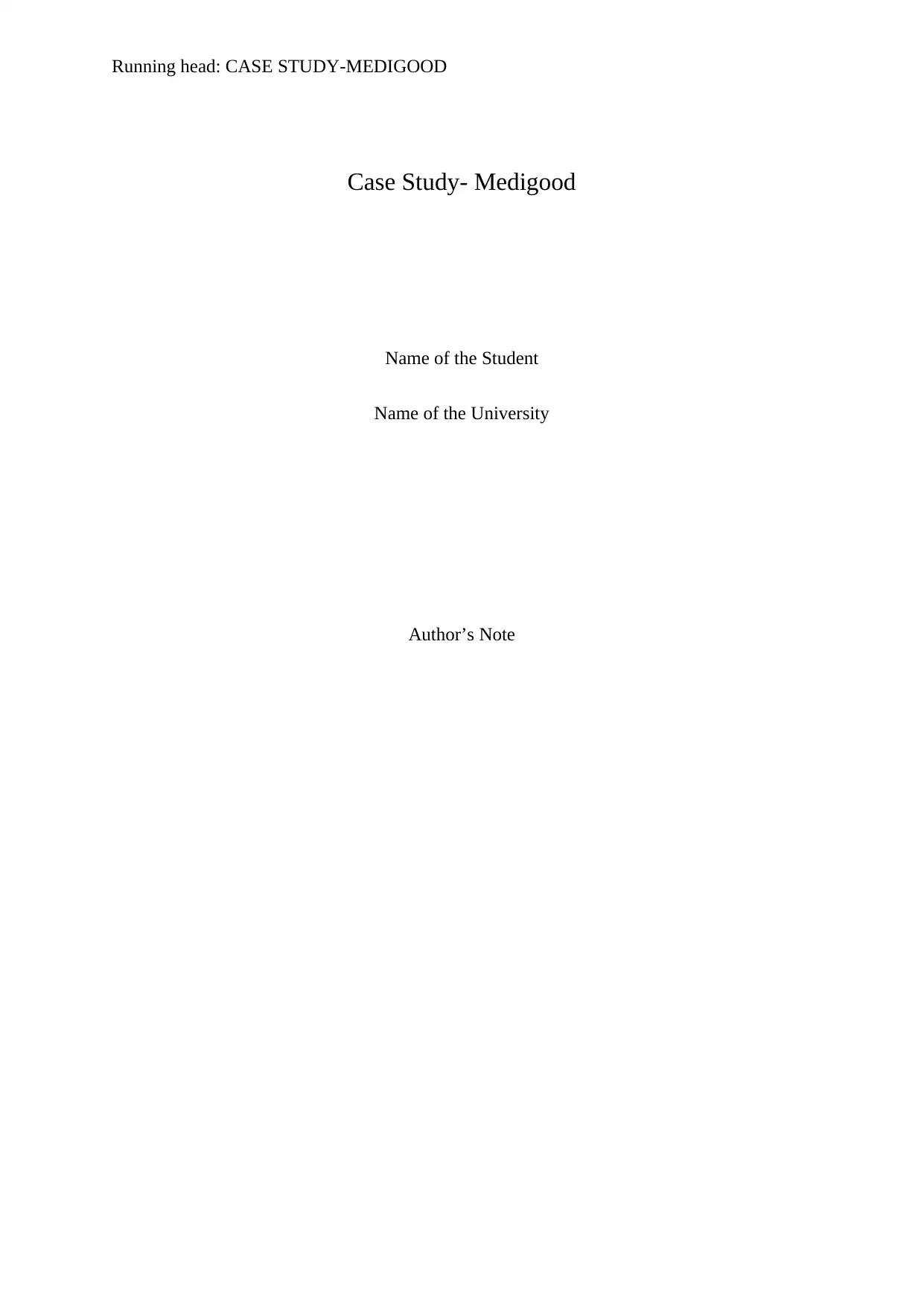
Running head: CASE STUDY-MEDIGOOD
Case Study- Medigood
Name of the Student
Name of the University
Author’s Note
Case Study- Medigood
Name of the Student
Name of the University
Author’s Note
Secure Best Marks with AI Grader
Need help grading? Try our AI Grader for instant feedback on your assignments.
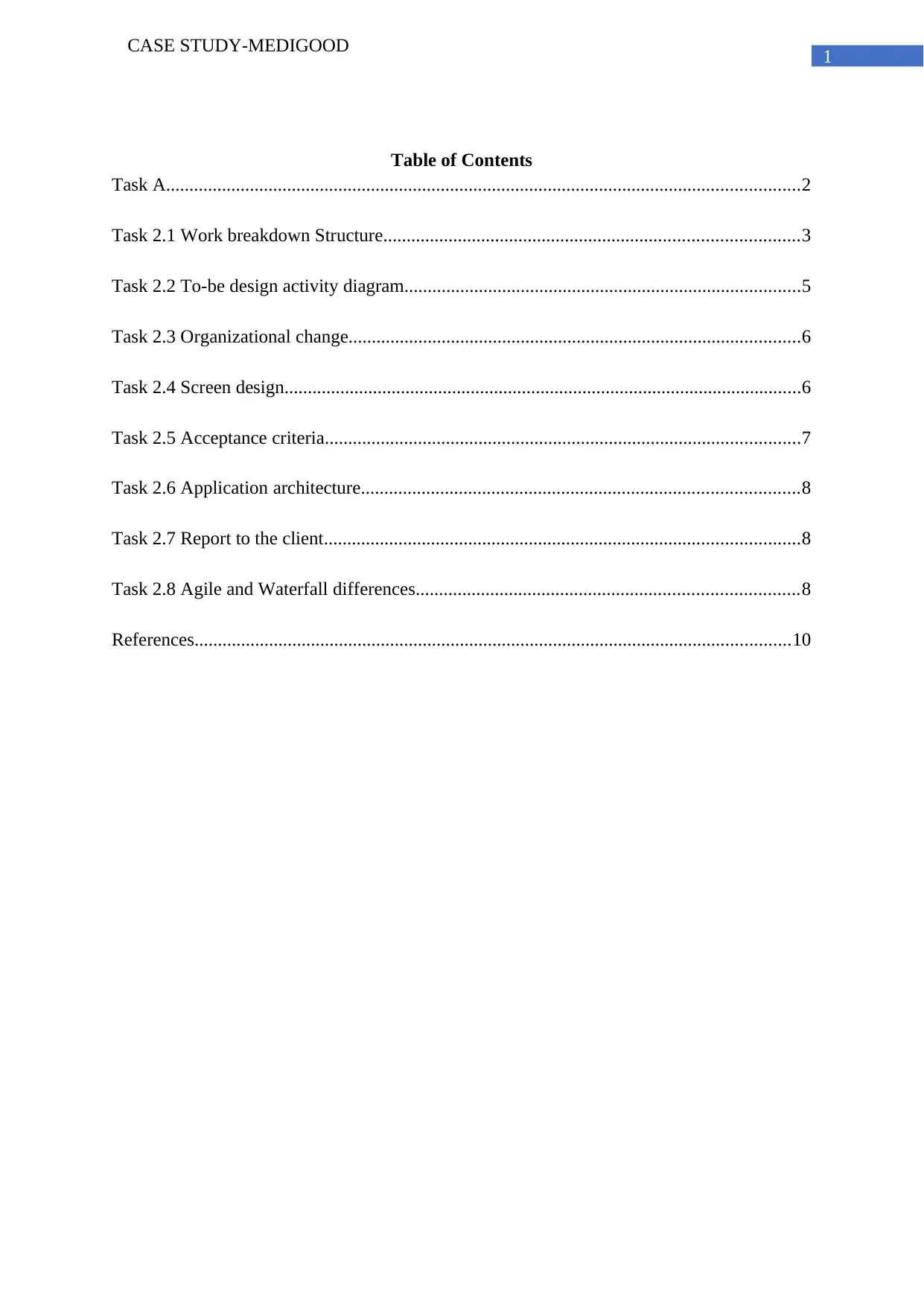
1
CASE STUDY-MEDIGOOD
Table of Contents
Task A........................................................................................................................................2
Task 2.1 Work breakdown Structure.........................................................................................3
Task 2.2 To-be design activity diagram.....................................................................................5
Task 2.3 Organizational change.................................................................................................6
Task 2.4 Screen design...............................................................................................................6
Task 2.5 Acceptance criteria......................................................................................................7
Task 2.6 Application architecture..............................................................................................8
Task 2.7 Report to the client......................................................................................................8
Task 2.8 Agile and Waterfall differences..................................................................................8
References................................................................................................................................10
CASE STUDY-MEDIGOOD
Table of Contents
Task A........................................................................................................................................2
Task 2.1 Work breakdown Structure.........................................................................................3
Task 2.2 To-be design activity diagram.....................................................................................5
Task 2.3 Organizational change.................................................................................................6
Task 2.4 Screen design...............................................................................................................6
Task 2.5 Acceptance criteria......................................................................................................7
Task 2.6 Application architecture..............................................................................................8
Task 2.7 Report to the client......................................................................................................8
Task 2.8 Agile and Waterfall differences..................................................................................8
References................................................................................................................................10
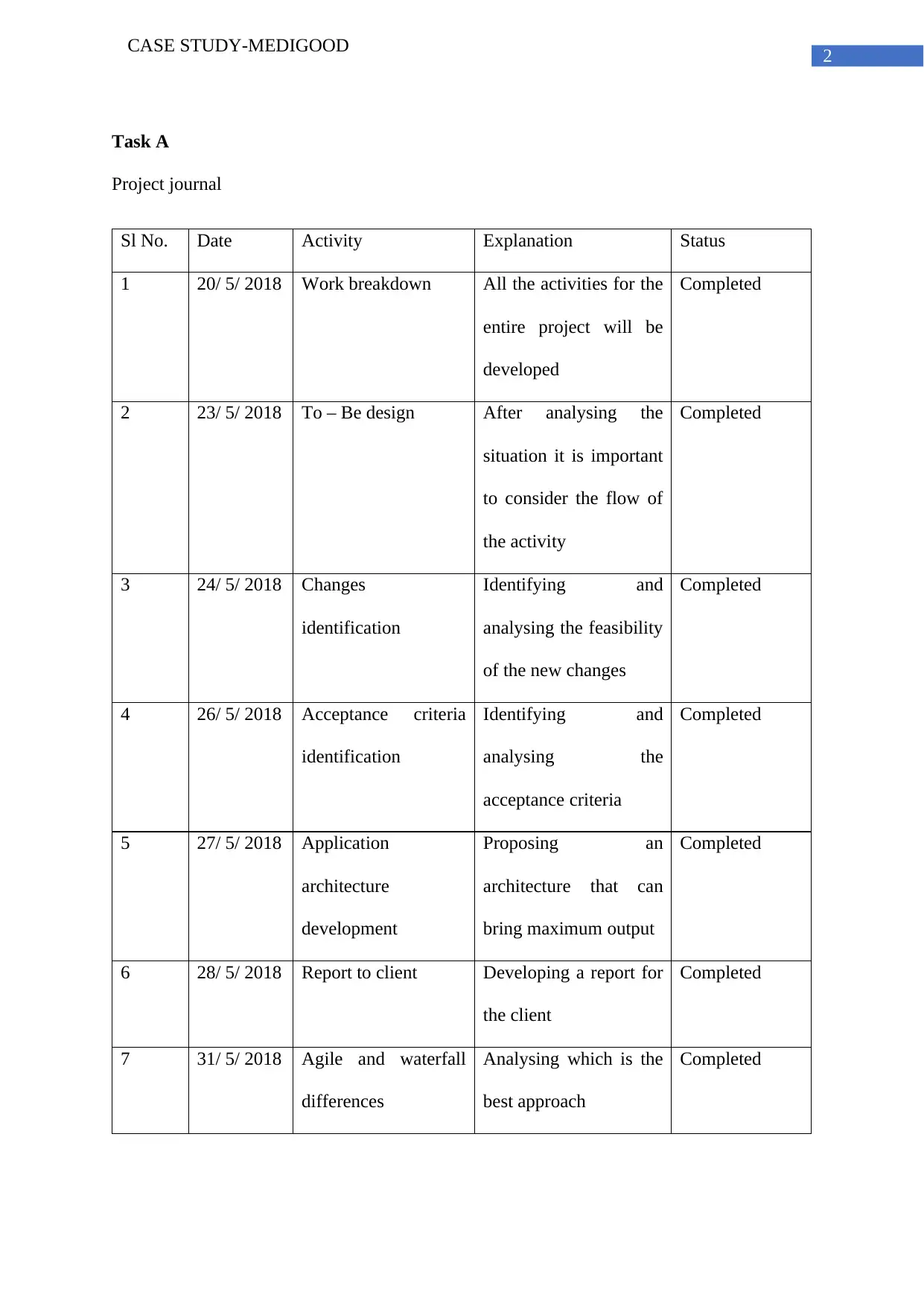
2
CASE STUDY-MEDIGOOD
Task A
Project journal
Sl No. Date Activity Explanation Status
1 20/ 5/ 2018 Work breakdown All the activities for the
entire project will be
developed
Completed
2 23/ 5/ 2018 To – Be design After analysing the
situation it is important
to consider the flow of
the activity
Completed
3 24/ 5/ 2018 Changes
identification
Identifying and
analysing the feasibility
of the new changes
Completed
4 26/ 5/ 2018 Acceptance criteria
identification
Identifying and
analysing the
acceptance criteria
Completed
5 27/ 5/ 2018 Application
architecture
development
Proposing an
architecture that can
bring maximum output
Completed
6 28/ 5/ 2018 Report to client Developing a report for
the client
Completed
7 31/ 5/ 2018 Agile and waterfall
differences
Analysing which is the
best approach
Completed
CASE STUDY-MEDIGOOD
Task A
Project journal
Sl No. Date Activity Explanation Status
1 20/ 5/ 2018 Work breakdown All the activities for the
entire project will be
developed
Completed
2 23/ 5/ 2018 To – Be design After analysing the
situation it is important
to consider the flow of
the activity
Completed
3 24/ 5/ 2018 Changes
identification
Identifying and
analysing the feasibility
of the new changes
Completed
4 26/ 5/ 2018 Acceptance criteria
identification
Identifying and
analysing the
acceptance criteria
Completed
5 27/ 5/ 2018 Application
architecture
development
Proposing an
architecture that can
bring maximum output
Completed
6 28/ 5/ 2018 Report to client Developing a report for
the client
Completed
7 31/ 5/ 2018 Agile and waterfall
differences
Analysing which is the
best approach
Completed
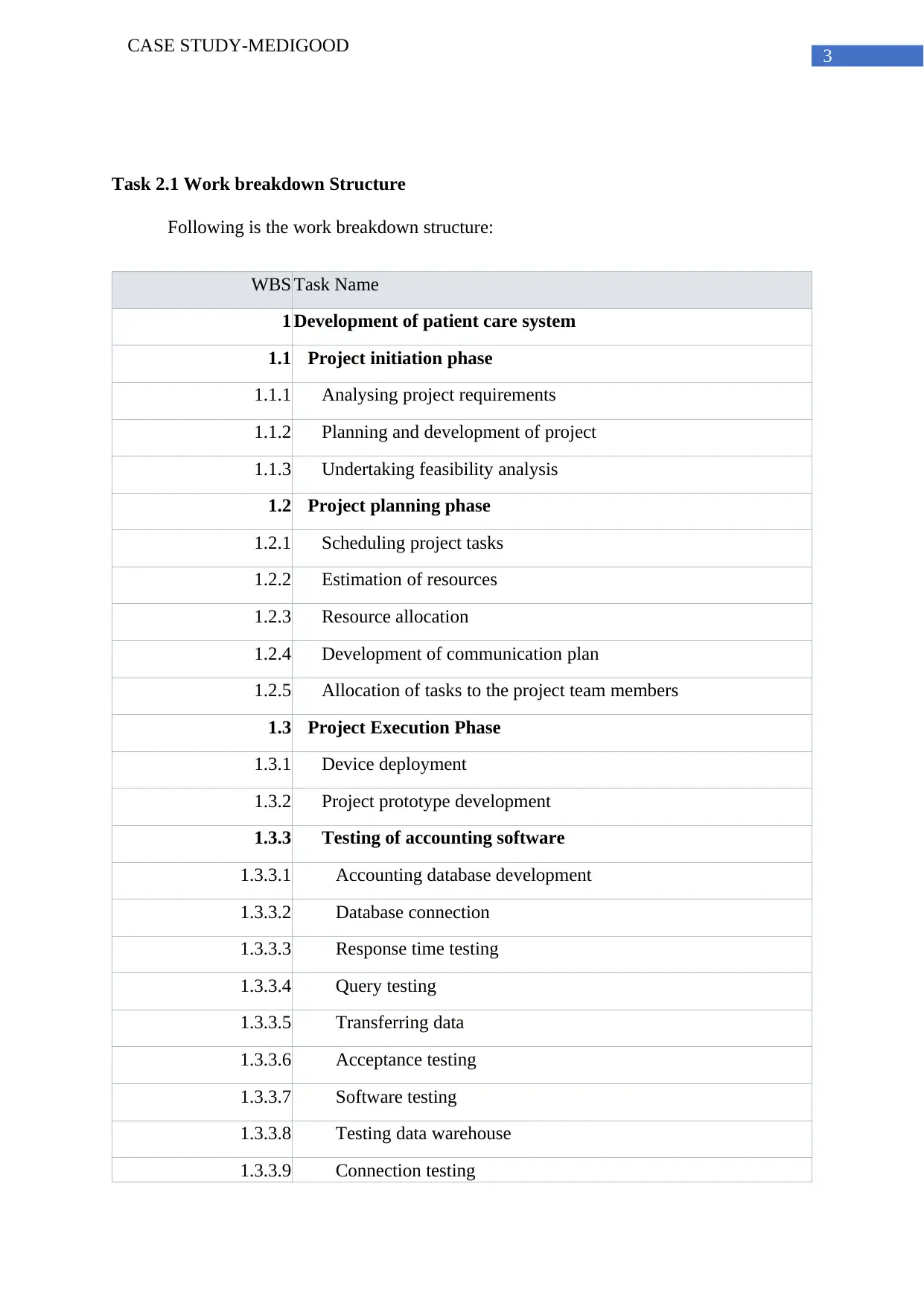
3
CASE STUDY-MEDIGOOD
Task 2.1 Work breakdown Structure
Following is the work breakdown structure:
WBS Task Name
1 Development of patient care system
1.1 Project initiation phase
1.1.1 Analysing project requirements
1.1.2 Planning and development of project
1.1.3 Undertaking feasibility analysis
1.2 Project planning phase
1.2.1 Scheduling project tasks
1.2.2 Estimation of resources
1.2.3 Resource allocation
1.2.4 Development of communication plan
1.2.5 Allocation of tasks to the project team members
1.3 Project Execution Phase
1.3.1 Device deployment
1.3.2 Project prototype development
1.3.3 Testing of accounting software
1.3.3.1 Accounting database development
1.3.3.2 Database connection
1.3.3.3 Response time testing
1.3.3.4 Query testing
1.3.3.5 Transferring data
1.3.3.6 Acceptance testing
1.3.3.7 Software testing
1.3.3.8 Testing data warehouse
1.3.3.9 Connection testing
CASE STUDY-MEDIGOOD
Task 2.1 Work breakdown Structure
Following is the work breakdown structure:
WBS Task Name
1 Development of patient care system
1.1 Project initiation phase
1.1.1 Analysing project requirements
1.1.2 Planning and development of project
1.1.3 Undertaking feasibility analysis
1.2 Project planning phase
1.2.1 Scheduling project tasks
1.2.2 Estimation of resources
1.2.3 Resource allocation
1.2.4 Development of communication plan
1.2.5 Allocation of tasks to the project team members
1.3 Project Execution Phase
1.3.1 Device deployment
1.3.2 Project prototype development
1.3.3 Testing of accounting software
1.3.3.1 Accounting database development
1.3.3.2 Database connection
1.3.3.3 Response time testing
1.3.3.4 Query testing
1.3.3.5 Transferring data
1.3.3.6 Acceptance testing
1.3.3.7 Software testing
1.3.3.8 Testing data warehouse
1.3.3.9 Connection testing
Secure Best Marks with AI Grader
Need help grading? Try our AI Grader for instant feedback on your assignments.
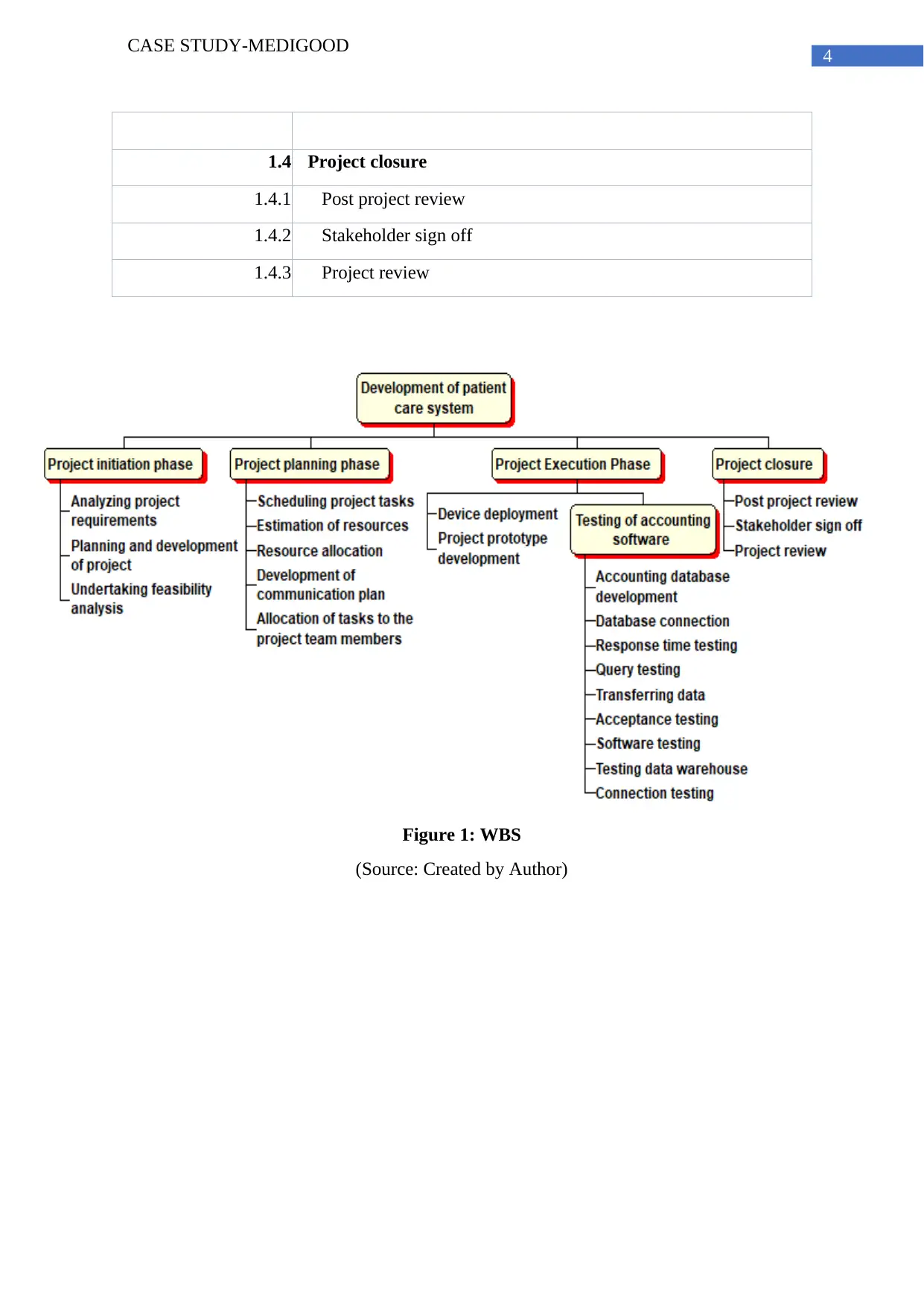
4
CASE STUDY-MEDIGOOD
1.4 Project closure
1.4.1 Post project review
1.4.2 Stakeholder sign off
1.4.3 Project review
Figure 1: WBS
(Source: Created by Author)
CASE STUDY-MEDIGOOD
1.4 Project closure
1.4.1 Post project review
1.4.2 Stakeholder sign off
1.4.3 Project review
Figure 1: WBS
(Source: Created by Author)

5
CASE STUDY-MEDIGOOD
Task 2.2 To-be design activity diagram
Figure 2: To- be design diagram
(Source: Created by Author)
The above to-be model presents the demonstration for the proposed system
functioning and how it will beneficial for the organization to utilize the services and provide
better services to the organization.
CASE STUDY-MEDIGOOD
Task 2.2 To-be design activity diagram
Figure 2: To- be design diagram
(Source: Created by Author)
The above to-be model presents the demonstration for the proposed system
functioning and how it will beneficial for the organization to utilize the services and provide
better services to the organization.
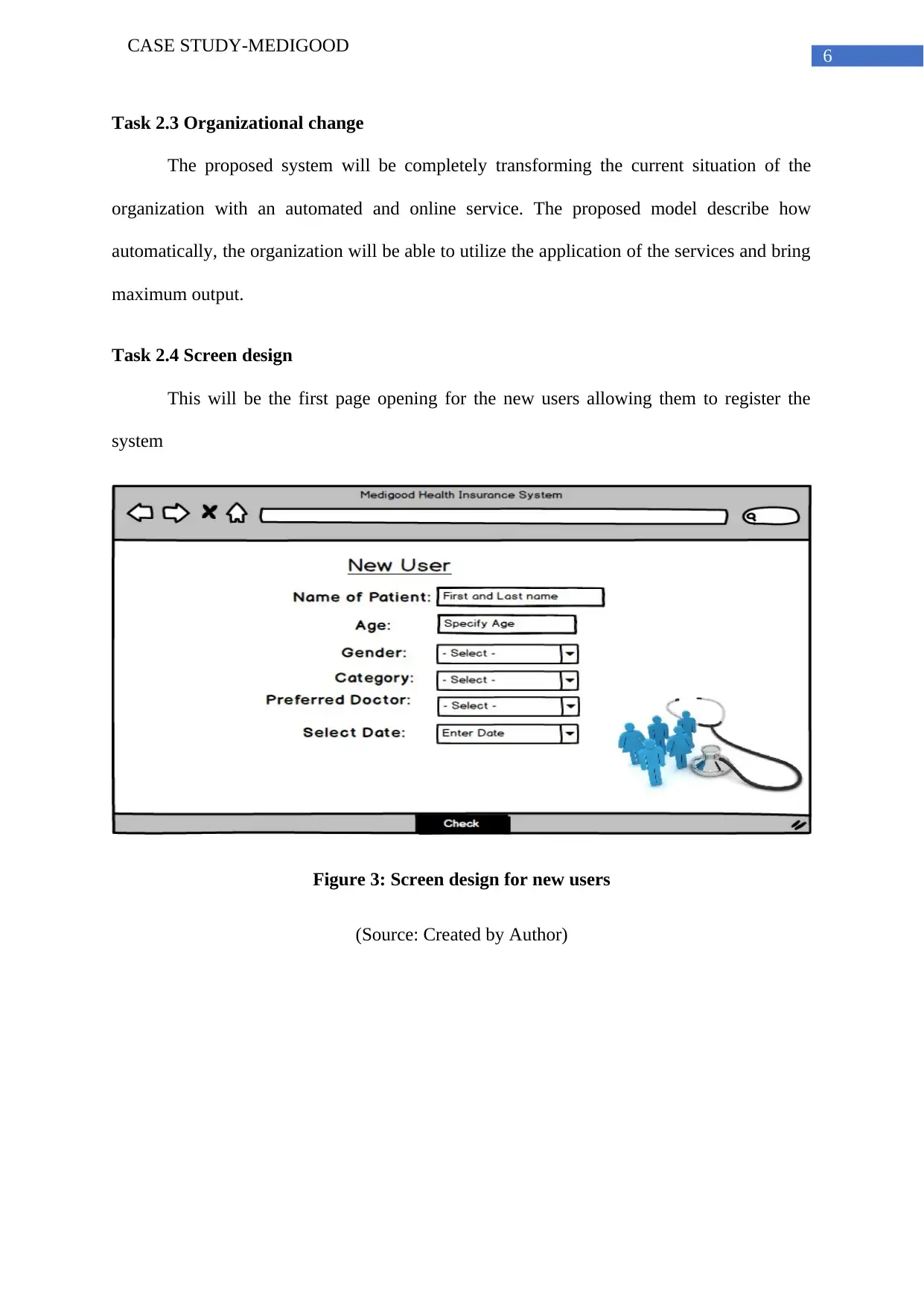
6
CASE STUDY-MEDIGOOD
Task 2.3 Organizational change
The proposed system will be completely transforming the current situation of the
organization with an automated and online service. The proposed model describe how
automatically, the organization will be able to utilize the application of the services and bring
maximum output.
Task 2.4 Screen design
This will be the first page opening for the new users allowing them to register the
system
Figure 3: Screen design for new users
(Source: Created by Author)
CASE STUDY-MEDIGOOD
Task 2.3 Organizational change
The proposed system will be completely transforming the current situation of the
organization with an automated and online service. The proposed model describe how
automatically, the organization will be able to utilize the application of the services and bring
maximum output.
Task 2.4 Screen design
This will be the first page opening for the new users allowing them to register the
system
Figure 3: Screen design for new users
(Source: Created by Author)
Paraphrase This Document
Need a fresh take? Get an instant paraphrase of this document with our AI Paraphraser
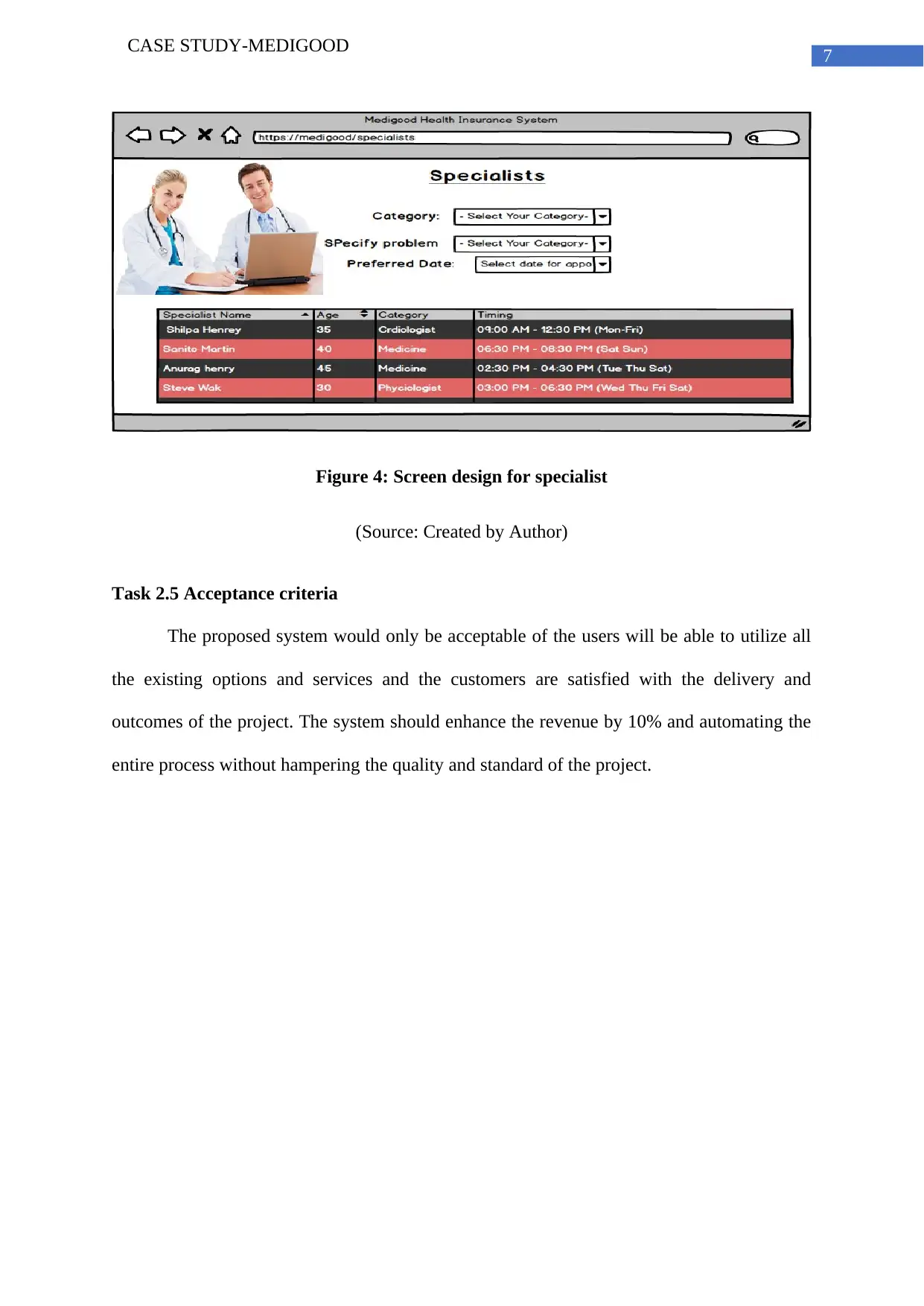
7
CASE STUDY-MEDIGOOD
Figure 4: Screen design for specialist
(Source: Created by Author)
Task 2.5 Acceptance criteria
The proposed system would only be acceptable of the users will be able to utilize all
the existing options and services and the customers are satisfied with the delivery and
outcomes of the project. The system should enhance the revenue by 10% and automating the
entire process without hampering the quality and standard of the project.
CASE STUDY-MEDIGOOD
Figure 4: Screen design for specialist
(Source: Created by Author)
Task 2.5 Acceptance criteria
The proposed system would only be acceptable of the users will be able to utilize all
the existing options and services and the customers are satisfied with the delivery and
outcomes of the project. The system should enhance the revenue by 10% and automating the
entire process without hampering the quality and standard of the project.
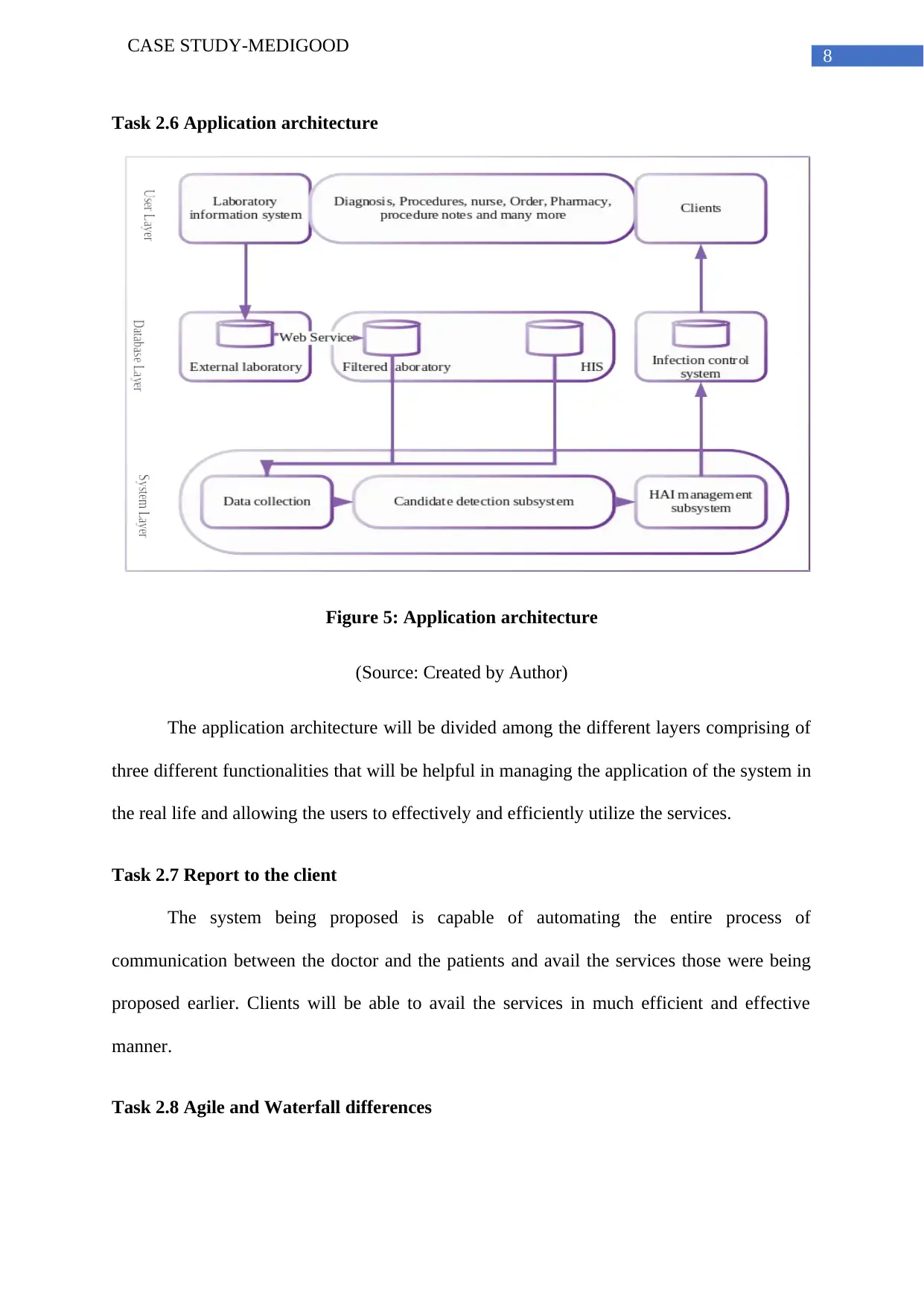
8
CASE STUDY-MEDIGOOD
Task 2.6 Application architecture
Figure 5: Application architecture
(Source: Created by Author)
The application architecture will be divided among the different layers comprising of
three different functionalities that will be helpful in managing the application of the system in
the real life and allowing the users to effectively and efficiently utilize the services.
Task 2.7 Report to the client
The system being proposed is capable of automating the entire process of
communication between the doctor and the patients and avail the services those were being
proposed earlier. Clients will be able to avail the services in much efficient and effective
manner.
Task 2.8 Agile and Waterfall differences
CASE STUDY-MEDIGOOD
Task 2.6 Application architecture
Figure 5: Application architecture
(Source: Created by Author)
The application architecture will be divided among the different layers comprising of
three different functionalities that will be helpful in managing the application of the system in
the real life and allowing the users to effectively and efficiently utilize the services.
Task 2.7 Report to the client
The system being proposed is capable of automating the entire process of
communication between the doctor and the patients and avail the services those were being
proposed earlier. Clients will be able to avail the services in much efficient and effective
manner.
Task 2.8 Agile and Waterfall differences
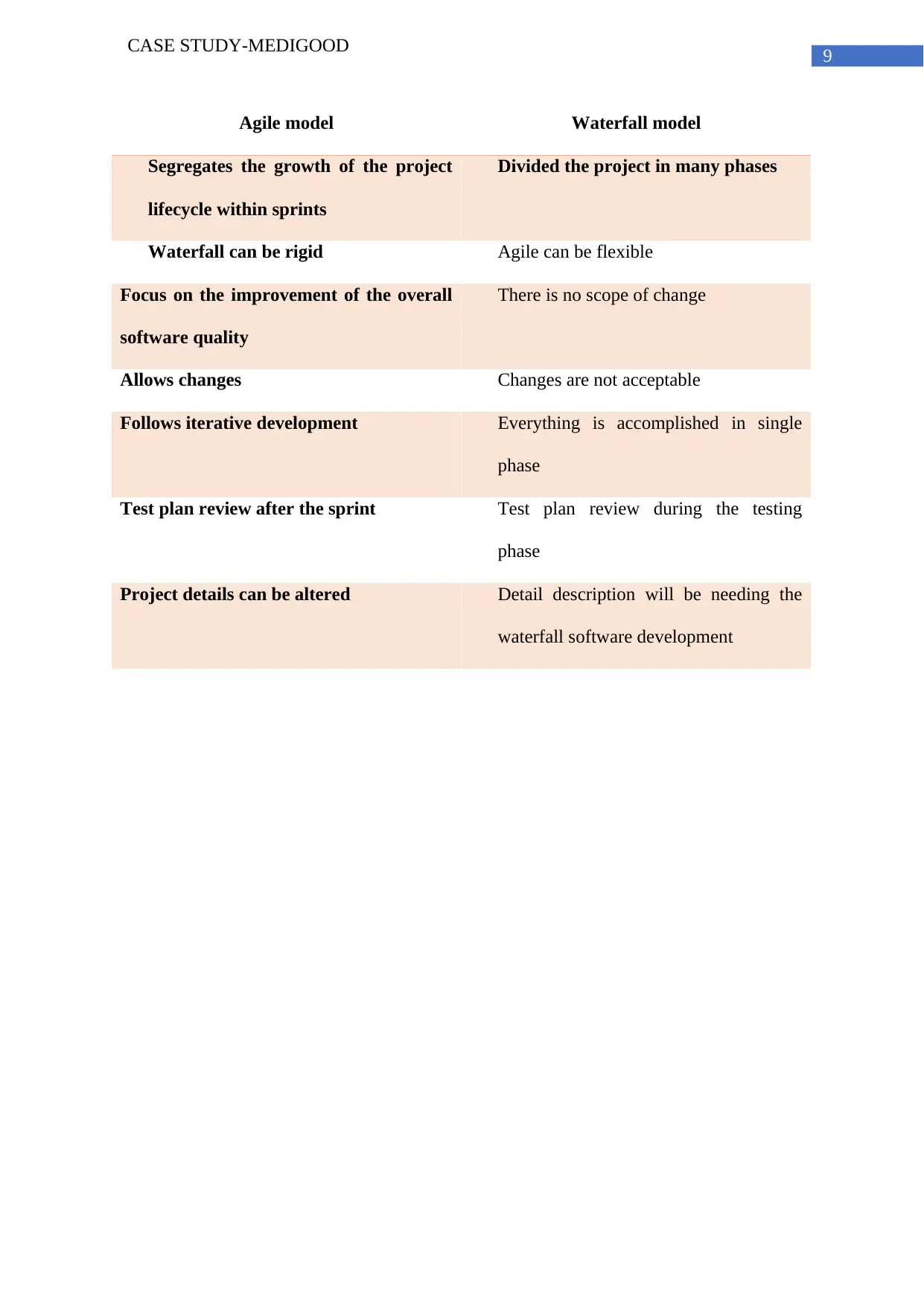
9
CASE STUDY-MEDIGOOD
Agile model Waterfall model
Segregates the growth of the project
lifecycle within sprints
Divided the project in many phases
Waterfall can be rigid Agile can be flexible
Focus on the improvement of the overall
software quality
There is no scope of change
Allows changes Changes are not acceptable
Follows iterative development Everything is accomplished in single
phase
Test plan review after the sprint Test plan review during the testing
phase
Project details can be altered Detail description will be needing the
waterfall software development
CASE STUDY-MEDIGOOD
Agile model Waterfall model
Segregates the growth of the project
lifecycle within sprints
Divided the project in many phases
Waterfall can be rigid Agile can be flexible
Focus on the improvement of the overall
software quality
There is no scope of change
Allows changes Changes are not acceptable
Follows iterative development Everything is accomplished in single
phase
Test plan review after the sprint Test plan review during the testing
phase
Project details can be altered Detail description will be needing the
waterfall software development
Secure Best Marks with AI Grader
Need help grading? Try our AI Grader for instant feedback on your assignments.

10
CASE STUDY-MEDIGOOD
References
De Thurah, A., Stengaard‐Pedersen, K., Axelsen, M., Fredberg, U., Schougaard, L.M.,
Hjollund, N.H., Pfeiffer‐Jensen, M., Laurberg, T.B., Tarp, U., Lomborg, K. and Maribo, T.,
2018. Tele‐Health Followup Strategy for Tight Control of Disease Activity in Rheumatoid
Arthritis: Results of a Randomized Controlled Trial. Arthritis care & research, 70(3), pp.353-
360.
Fleisher, C. S., & Bensoussan, B. E. (2015). Business and competitive analysis: effective
application of new and classic methods. FT Press.
Goetsch, D.L. and Davis, S.B., 2014. Quality management for organizational excellence.
Upper Saddle River, NJ: pearson.
Gollenia, L.A., 2016. Business transformation management methodology. Routledge.
Greenhalgh, T., Procter, R., Wherton, J., Sugarhood, P., Hinder, S. and Rouncefield, M.,
2015. What is quality in assisted living technology? The ARCHIE framework for effective
telehealth and telecare services. BMC medicine, 13(1), p.91.
Hair Jr, J. F., Wolfinbarger, M., Money, A. H., Samouel, P., & Page, M. J. (2015). Essentials
of business research methods. Routledge.
Hall, J.L. and McGraw, D., 2014. For telehealth to succeed, privacy and security risks must
be identified and addressed. Health Affairs, 33(2), pp.216-221.
Hiekata, K., Mitsuyuki, T., Goto, T. and Moser, B.R., 2016, October. Design of Software
Development Architecture Comparison of Waterfall and Agile Using Reliability Growth
Model. In ISPE TE (pp. 471-480).
CASE STUDY-MEDIGOOD
References
De Thurah, A., Stengaard‐Pedersen, K., Axelsen, M., Fredberg, U., Schougaard, L.M.,
Hjollund, N.H., Pfeiffer‐Jensen, M., Laurberg, T.B., Tarp, U., Lomborg, K. and Maribo, T.,
2018. Tele‐Health Followup Strategy for Tight Control of Disease Activity in Rheumatoid
Arthritis: Results of a Randomized Controlled Trial. Arthritis care & research, 70(3), pp.353-
360.
Fleisher, C. S., & Bensoussan, B. E. (2015). Business and competitive analysis: effective
application of new and classic methods. FT Press.
Goetsch, D.L. and Davis, S.B., 2014. Quality management for organizational excellence.
Upper Saddle River, NJ: pearson.
Gollenia, L.A., 2016. Business transformation management methodology. Routledge.
Greenhalgh, T., Procter, R., Wherton, J., Sugarhood, P., Hinder, S. and Rouncefield, M.,
2015. What is quality in assisted living technology? The ARCHIE framework for effective
telehealth and telecare services. BMC medicine, 13(1), p.91.
Hair Jr, J. F., Wolfinbarger, M., Money, A. H., Samouel, P., & Page, M. J. (2015). Essentials
of business research methods. Routledge.
Hall, J.L. and McGraw, D., 2014. For telehealth to succeed, privacy and security risks must
be identified and addressed. Health Affairs, 33(2), pp.216-221.
Hiekata, K., Mitsuyuki, T., Goto, T. and Moser, B.R., 2016, October. Design of Software
Development Architecture Comparison of Waterfall and Agile Using Reliability Growth
Model. In ISPE TE (pp. 471-480).

11
CASE STUDY-MEDIGOOD
Hornstein, H.A., 2015. The integration of project management and organizational change
management is now a necessity. International Journal of Project Management, 33(2), pp.291-
298.
Kanaane, R., Akabane, G., Peterossi, H. and Endler, D.C.N., 2015. Organizational change
management in a strategic perspective. American Journal of Management, 15(2), p.88.
Kaufman, H., 2017. The limits of organizational change. Routledge.
Komai, S., Saidi, H. and Nakanishi, H., 2016. Man-Hour Comparison Between Two Methods
of Agile and Waterfall in IT System Development. INNOVATION AND MANAGEMENT,
p.1707.
Mahadevan, L., Kettinger, W.J. and Meservy, T.O., 2015. Running on Hybrid: Control
Changes when Introducing an Agile Methodology in a Traditional" Waterfall" System
Development Environment. CAIS, 36, p.5.
Mitsuyuki, T., Hiekata, K., Goto, T. and Moser, B., 2017. Evaluation of Project Architecture
in Software Development Mixing Waterfall and Agile by Using Process Simulation. Journal
of Industrial Integration and Management, 2(02), p.1750007.
Serrador, P. and Pinto, J.K., 2015. Does Agile work?—A quantitative analysis of agile
project success. International Journal of Project Management, 33(5), pp.1040-1051.
Steinke, G.H., Al-Deen, M.S. and LaBrie, R.C., 2017. NNOVATING INFORMATION
SYSTEM DEVELOPMENT METHODOLOGIES WITH DESIGN THINKING. In
Proceedings of the 5th International Conference on Applied Innovations in IT (pp. 51-55).
Vijayasarathy, L.R. and Butler, C.W., 2016. Choice of software development methodologies:
Do organizational, project, and team characteristics matter?. IEEE Software, 33(5), pp.86-94.
CASE STUDY-MEDIGOOD
Hornstein, H.A., 2015. The integration of project management and organizational change
management is now a necessity. International Journal of Project Management, 33(2), pp.291-
298.
Kanaane, R., Akabane, G., Peterossi, H. and Endler, D.C.N., 2015. Organizational change
management in a strategic perspective. American Journal of Management, 15(2), p.88.
Kaufman, H., 2017. The limits of organizational change. Routledge.
Komai, S., Saidi, H. and Nakanishi, H., 2016. Man-Hour Comparison Between Two Methods
of Agile and Waterfall in IT System Development. INNOVATION AND MANAGEMENT,
p.1707.
Mahadevan, L., Kettinger, W.J. and Meservy, T.O., 2015. Running on Hybrid: Control
Changes when Introducing an Agile Methodology in a Traditional" Waterfall" System
Development Environment. CAIS, 36, p.5.
Mitsuyuki, T., Hiekata, K., Goto, T. and Moser, B., 2017. Evaluation of Project Architecture
in Software Development Mixing Waterfall and Agile by Using Process Simulation. Journal
of Industrial Integration and Management, 2(02), p.1750007.
Serrador, P. and Pinto, J.K., 2015. Does Agile work?—A quantitative analysis of agile
project success. International Journal of Project Management, 33(5), pp.1040-1051.
Steinke, G.H., Al-Deen, M.S. and LaBrie, R.C., 2017. NNOVATING INFORMATION
SYSTEM DEVELOPMENT METHODOLOGIES WITH DESIGN THINKING. In
Proceedings of the 5th International Conference on Applied Innovations in IT (pp. 51-55).
Vijayasarathy, L.R. and Butler, C.W., 2016. Choice of software development methodologies:
Do organizational, project, and team characteristics matter?. IEEE Software, 33(5), pp.86-94.
1 out of 12
Related Documents
Your All-in-One AI-Powered Toolkit for Academic Success.
+13062052269
info@desklib.com
Available 24*7 on WhatsApp / Email
![[object Object]](/_next/static/media/star-bottom.7253800d.svg)
Unlock your academic potential
© 2024 | Zucol Services PVT LTD | All rights reserved.



